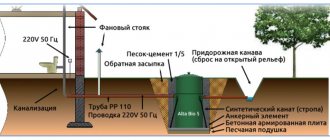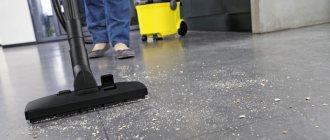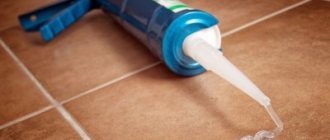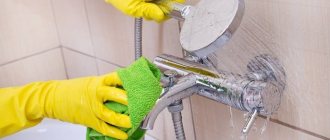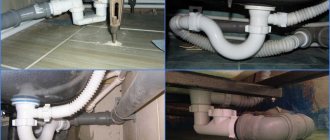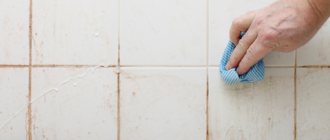The “aroma” of sewage, especially in the place where food is prepared, evokes the most negative emotions. Therefore, eliminating odor from your kitchen sink becomes a top priority. There can be several sources at once, and therefore the methods of disposal are different. His choice depends on the cause of the problem. It is necessary to check the sewer and siphon, and use a cable, plunger and cleaning products to eliminate the smell.
Why does the sink smell?
Before dealing with an unpleasant odor, I recommend eliminating its root cause. Otherwise, the unpleasant aroma will appear again and again, and you will get tired of fighting endlessly.
Incorrect installation of siphon or corrugation
Incorrect installation fully affects the appearance of unpleasant odor from the sink. This happens for 3 reasons:
- There is no liquid in the water seal. If installed incorrectly, the plastic pipe does not reach the required level of the liquid level in the flask. It is important to correctly adjust the fitting depth of the pipe so that all the water does not go down the drain, but also does not pour back into the sink.
- The liquid in the water seal has evaporated. If you do not use the sink for a long time, over time the water in the siphon will evaporate, which will cause a stench to appear from the sewer. To prevent this, before a long absence, pour a little vegetable oil into the drain, which will prevent the moisture from completely evaporating.
- The siphon has sagged or the corrugation has stretched. Such a problem will require replacing components or repairing the siphon.
Siphon contamination
The curved shape of the siphon essentially prevents the penetration of unpleasant odors. However, if there is a build-up on the walls of the knee from dirty water or food waste, an unpleasant odor begins to emanate from the sink. This happens even if you keep the sink clean and use special drainage screens.
Stagnation
A similar reason appears when the siphon is used for a long time without hygienic cleaning. During operation, plaque accumulates on the walls, which, as it grows, narrows the drain hole. As a result, the water leaves more slowly, forming stagnation in the pipe, which begins to rot, emitting an unpleasant odor. It is better to deal with such a problem with the help of professionals or through the use of special means.
Violation of tightness
If the installation of the sink and its components was not carried out properly, an unpleasant smell will soon appear in the kitchen. This happens because the joints were not sealed correctly. As a result, fumes from sewer systems penetrate through openings that should have been closed. Fortunately, this type of problem is fairly easy to spot and easy to fix. Typically, water leaks through leaking joints, which can cause mold to form, so it’s best to fix the problem as quickly as possible.
Other reasons
Sometimes the source of the odor can be other parts of the sewer system. For example, a drain pipe cracks or air appears in the riser. Only plumbers from the management company can solve such problems.
How to find the cause or breakdown
If you begin to notice that the room smells like sewage, try to find and eliminate the cause as quickly as possible.
First, check all pipes of the sewer system for damage. If a problem is found in this area, call a plumber. If there are no problems with the pipes, check the siphon under the sink. However, only an external examination is not enough. Be sure to dismantle the siphon and corrugation, and look at the system from the inside. If you find a blockage or plaque, clean the siphon and put it back in place, in the same position as before. If you notice a malfunction in the siphon, it is better to replace it with a new one. Otherwise, the smell will reappear.
Why does my bathtub smell like sewer?
The second most common source of unpleasant odor is the drain hole in the bathroom. In this case, there are 5 main problems, which we will discuss below. So, let's figure out why the bathtub smells like sewage and what to do?
Reason No. 6 – a large number of joints
Sometimes a bathtub drain is made from a large number of elements. Accordingly, there are joints between them. These are places where dirt accumulates and plaque forms. They can be sources of unpleasant odors. When connecting the bathtub to the sewer, follow the rule: the fewer elements, the better.
You can only discover that dirt has accumulated in the joints by disassembling them. But even if it is not there, remake the drain system so that it has a minimum of pipes, elbows and couplings. This is a good preventative against unpleasant odor.
Blue lines indicate joints where dirt can accumulate. In this case there are 10 of them. This is too many for a short area.
Reason No. 7 - sagging drain pipe
Typically, the bathtub is positioned so that the drain is closer to the sewer connection. If it is located the other way around, they are connected by a long pipe. It may sag due to poor quality materials or improper installation. At the same time, dirty water stagnates in the place of sagging and dirt accumulates.
You can determine the sagging of the drainage pipe by eye. If in some place it is located horizontally, place a support under it so that it is located at an angle along its entire length. This will ensure normal water drainage from the bathtub.
Reason No. 8 – incorrect slope of the drainage
If, as in the previous case, the bathtub drain hole is located far from the entrance to the sewer, they are connected by a drainage pipe. It should be located at an angle so that water and dirt do not stagnate. If the angle is insufficient, there is a possibility that a sewer smell will appear in the bathroom.
Important
The slope must be at least 3 cm for each linear meter of pipe. But the more, the better. This also applies to other elements - corners, tees.
As a rule, insufficient pipe slope is caused by leaving too high a vertical part of the pipes near the drain or sewer. The fix is easy - make these parts as short as possible. If the bathtub is installed low, then the only option is to raise it.
In this case, the drain pipe is not installed correctly. It is not even located horizontally. The slope goes towards the drain hole, not away from it.
Reason No. 9 – connection without a water seal
As in the case of a sink, the bath drains through a water seal. Sometimes it is implemented initially, in the form of an S-shaped elbow of a cast iron sewer pipe. In other cases, a siphon is made when installing and connecting the bathtub. It comes in three types:
- Bottle;
- Tubular;
- Corrugated.
If there is no water seal, gases from the drain will flow into the drain. This will cause the bathroom to smell like sewer. The problem can only be solved by installing a water seal. Its type must be chosen based on the distance between the bathroom and the floor. At the same time, do not forget that you need to maintain the slope of the drain pipe.
Reason #10 – horizontal drain elements
Some plumbers make complex designs when connecting the bathtub drain to the sewer. However, the slope is not always observed. Dirt and water accumulate in horizontal areas, causing the bathtub to smell like sewer. The problem can be solved in three ways:
- Make the most direct drain possible, with a minimum of elements. Ideally it should be one straight pipe.
- If the water seal is located on the side of the sewer connection, move it closer to the bathtub drain hole.
- Position all drainage elements so that they are inclined. To do this, use supports.
Why is sewer smell dangerous?
You should not be tolerant of the appearance of an unpleasant smell from the sewer. The stench that comes from sewer systems is not only downright stinky, but also harmful to your health.
This is usually the smell of hydrogen sulfide and ammonia, which, if regularly inhaled, can cause disruptions in the functioning of the human body, in particular, damage to the nervous and respiratory systems. Along with them, no less harmful methane enters the organ systems, aggravating the situation. Long-term exposure to these substances can cause imbalance or anxiety and even fainting.
Prevention
You can not only get rid of unpleasant smell from the sink, but also prevent it if you strictly follow simple rules:
- Clean the sewer pipes not only when an odor appears from the sink, but also regularly (monthly). Salt and soda should be used once a week. This sequence of processing allows you to maintain the relative cleanliness of plumbing fixtures.
- Never flush leftover food and tea leaves down the kitchen drain. They are the ones who clog the siphon.
- When going on vacation or a long business trip, you should take care of the condition of the plumbing by pouring oil (vegetable or machine) into the siphon. Volume – small glass. This will help avoid evaporation of moisture and drying out of pipes, which gives off a sewer “aroma.” When you return, you just need to rinse the drain with warm water and detergent.
- If it is necessary to replace pipes or a siphon, you should entrust the work to a specialist.
- Choosing new plumbing fixtures should also be done by a professional. You need to focus on ease of use and quality. It would be better if the siphon is removable. This does not require complete dismantling of the pipes for cleaning.
Features of eliminating odor from a bathroom sink
The procedure for cleaning pipes in the bathroom is similar to flushing the sewer system in the kitchen. The peculiarities of eliminating sewer smell in the bathroom are other root causes of its occurrence. The reasons for the appearance of stench from the sewer in the bathroom can be:
- absence of water blockage with direct drainage;
- small volume of the drain element.
If the drain structure is connected according to all the rules, but the smell is still present, install a non-return air valve on the drain pipe, which will prevent fumes from the sewer from entering the drain.
Installation of a home sink
The sink bowl is connected using an outlet and a 20 cm tube with a siphon.
Barrel-shaped siphon
A siphon is a curved pipe located under the sink bowl. This element is necessary in the design so that the water in it does not allow the smell from the sewer to rise up. The water seal creates a seal for odor from the riser, preventing it from entering the room.
A water seal is a water lock.
There are self-flushing (corrugated) and barrel-shaped (or flask) siphons. The latter have a removable element that can be removed and cleaned without disconnecting the siphon from the sink.
You may be interested in information on how to assemble a siphon
The water is drained through the pipe, but the last part of it always remains in the siphon elbow, which is shaped like an English S, to protect the fresh air in your home. Regardless of the siphon design, there is always water inside. The slightest violation of this principle will lead to the spread of stench in your home.
The water lock does not allow the smell to rise to the top
How to get rid of smell from the sink using improvised means
If there is an unpleasant smell from the sink due to the formation of plaque on the walls or blockages, first of all try using available substances.
Soda
An excellent antiseptic that fights plaque and food deposits in pipes. Before using the product, clean the drain if it is clogged mechanically.
Procedure:
- Prepare your ingredients. You will need 150 g of soda and 500 ml of water.
- Dissolve baking soda in boiling water.
- Pour the solution into the sink drain.
- Leave to act for 30–40 minutes.
- Rinse the drain with hot water.
If the smell does not disappear, repeat the steps.
Soda and vinegar
A mixture of baking soda and vinegar helps not only eliminate the odor, but also clear the clog.
Operating procedure:
- Heat the required amount of vinegar slightly. To avoid inhaling fumes while heating, turn on the hood or open the windows.
- Prepare the same amount of soda.
- Pour baking soda into the drain and immediately pour hot vinegar over it.
- Cover the drain hole with a plug or piece of cloth.
- Leave the sink in this position for 30 minutes.
- After the required time, pour 2 liters of boiling water into the drain.
- After this, flush the drain with copious amounts of hot water.
The product is suitable for cleaning pipes made of all possible materials.
Salt
Table salt works well not only with odor, but also with residual grease and dirt.
Keep in mind that after rinsing, the sink cannot be used for about 8 hours, so it is better to perform the procedure at night.
Description of the method:
- Dilute 150 g of salt in 2 liters of just boiled water.
- Pour the saline solution into the sink.
- Leave for 5-8 hours.
- Flush the drain with copious amounts of hot water.
Repeat the procedure until you achieve the desired result. For greater effectiveness, you can add a little soda to the solution.
Lemon acid
Although citric acid is commonly used to remove carbon deposits and scale, it is also good at removing plaque and unpleasant odors. For the procedure you will need 100 g of citric acid.
Description of work:
- Pour the substance into the sink drain.
- Leave to act for 25-30 minutes.
- Flush the drain with copious amounts of water.
After using citric acid, the water will drain from the sink faster and the unpleasant odor will disappear.
Dry mustard
Mustard powder is known as a substance that perfectly fights fat deposits, which is especially useful for eliminating unpleasant odors from the sink. For the procedure you will need 100 g of mustard powder and 1 liter of boiling water.
Operating procedure:
- Pour mustard into the drain hole.
- Pour boiling water over it.
- Leave for 20-30 minutes to work.
- Flush the drain with copious amounts of hot water.
Please note that if the sink is clogged, it is not recommended to use mustard powder.
How does a water seal work?
Every plumbing fixture that is used in the bathroom and connected to the sewer system has a siphon. A siphon is a special device that does not allow foreign odors to penetrate from the sewer pipe into the room. It is made of brass, plastic or other material.
Siphon
There are models of siphons with a water seal, a membrane seal and a dry seal. Thanks to its special curved shape with one elbow, this device creates a water plug inside that prevents air from the sewer pipe from entering the sink or bathtub. Siphons perform the following functions:
- Removes unpleasant odors that may enter the room from the sewer pipe. While the plumbing fixture is being used and the water in the water seal does not dry out, air from there cannot penetrate up the pipe.
- Protects against sewer blockages. They filter out large debris that ends up in your sink or bathtub drain. All large impurities fall into the siphon sump, after which it can be removed from there.
- Sewage is directed by gravity into the sewer system. The shape of the siphon is such that wastewater easily flows through the drain into the sewer system without stagnating at the bottom of the sink or bathtub.
Please note that the water seal only works until the water in it dries out. Therefore, when no one uses a plumbing fixture for a long time or there is no water supply for a long time, the liquid in the siphon dries out, which is why there may be a sewer smell in the bathroom.
If the reason that the bathroom smells is because the water seal has dried out, then the easiest way to deal with this problem is to simply fill the siphon with water and thoroughly ventilate the room.
How to remove odor from a sink using mechanical methods
If the cause of the stench from the sewer is a blockage, before using odor elimination products, clean the drain using any mechanical method.
plunger
This cleaning method is the most affordable and simplest. Usually a plunger copes with the cleaning task the first or second time.
Mode of application:
- Place the plunger in the sink.
- Press the rubber pad firmly against the drain hole so that it completely covers it.
- Pour some hot water into the sink.
- Grab the handle of the plunger, alternately apply pressure and release several times in a row.
- After the last press, quickly remove the plunger from the sink.
- Repeat the procedure if necessary.
After all manipulations, rinse the drain with plenty of hot water.
Metal cable
If waste has accumulated far from the drain hole, the plunger will not have enough power to clear the pipe. In such a case, use a steel plumbing cable. The end of the tool usually has a hook or brush to help break through the clog.
Action plan:
- Remove the siphon elbow.
- Point the end of the cable into the hole and carefully push it inside the pipe.
- When you feel that the cable has collided with the plug, try to push it even deeper with pushing or rotating movements in different directions.
- Remove the cable from time to time; the hook may catch part of the blockage.
- If the cable begins to move easily, it means that the debris has been removed.
After the procedure, return the knee to its place and rinse the drain with hot water.
Country hose
The method of removing blockages using hydrodynamics, well known among plumbers, can be carried out at home without the use of expensive equipment. For the procedure you will need a regular thin hose, a nail and a soldering iron.
Scheme for manufacturing the device:
- Cut a piece of hose to the required length.
- Seal one end of it so that it does not allow liquid to pass through.
- At a distance of about 10 cm from the soldered end, use a hot nail to make several holes in a circle.
- The product is ready.
Instructions for use:
- Push the blind end of the hose into the clogged pipe.
- Attach the open end tightly to the tap.
- Turn on the water at high pressure.
- During the process, water will come out of the side holes under pressure, washing away accumulated contaminants.
- After this, remove the hose from the pipe and rinse the drain with hot water.
The procedure will help get rid of plaque and food debris.
Analysis of the plumbing unit
If there is a smell, but no blockages are found, check the pipes. Perhaps the stench from the sewer is coming to you due to contamination of the riser or plumbing unit. This is possible if the pipes are damaged or connected incorrectly. First, inspect all pipes for damage. Then disassemble the plumbing unit and reassemble it, carefully sealing the joints.
How to remove an unpleasant odor?
There are several ways to eliminate it.
Cable
A regular metal cable is not suitable. You need a special one, plumbing, at least 5 meters long. It is equipped with a brush or hook that can lift the clog. The handle is also specific: it allows you to rotate the cable.
To remove a garbage plug this way, you should:
- Clear access to the corrugation.
- Insert the cable into it to the maximum depth.
- Start “screwing” it with your hands until it reaches the blockage.
- Use a hook to pull out the debris or push the plug further.
- You can try to break up the blockage with a cable, moving it in different directions.
After manipulation, wash the cable and lubricate it with machine oil. Then roll it up and put it away.
plunger
It is used if you are completely sure that the siphon is clogged and there is no desire to disassemble it.
Necessary:
- Place the plunger cap over the drain and, opening the hot water tap, wait until it completely covers it.
- Close the tap and forcefully move the plunger up and down, then sharply pull it out along with part of the blockage.
- Turn on hot water and rinse the sink.
If you don’t have a plunger at home, you can repeat the same steps using a milk or juice carton, cutting off the top of the package.
Siphon
They disassemble the siphon only if they are completely sure that it is the cause of the unpleasant odor. The test will be the following procedure: you need to pull the corrugation out of the riser, lower it into a container, turn on the water and see if there is a leak. If it is missing, the siphon is disassembled and cleaned:
- First unscrew the bottom part. If this is not the problem, continue disassembling.
- Remove all nuts and carefully inspect the pipes.
- Remove the blockage.
- Rinse the siphon.
- Putting all the parts together.
When assembling, be sure to use the instructions; if you followed them, the sink should work normally.
Cleaners
They can be from improvised products or professional ones. The most popular:
- Salt. The whole glass is poured into the sink and filled with half a liter of boiling water. After 3 hours, hot water opens and the entire drain is washed.
- Soda with salt. The mixture is prepared in a 1:1 ratio, after which it is also poured into the drain. After half an hour, it is washed with boiling water and the procedure is repeated. If this does not help get rid of the smell, then another cleaning method is chosen.
- Vinegar with soda. Proportions: pour two large spoons of soda into the siphon and then pour a glass of vinegar there. The drain is closed with a stopper, and 10 minutes after the end of the reaction, it is thoroughly washed with boiling water.
- A packet of citric acid concentrate in powder form is poured into the drain and hot water is turned on. A reaction like vinegar and soda begins. The further algorithm is the same. Dry mustard can be a substitute for lemon powder.
- Professional products include chemicals for cleaning pipes: Mole, Domestos, Brawl, Odorgon, Mister Muscle, Sanox, Belizna. To rinse the siphon, you must follow the instructions and take into account that the powder is more active than the liquid.
How to eliminate sewer smell using household chemicals
In the departments of household chemicals you will find special products for removing blockages and odors from the sink in a wide variety. They help remove unpleasant odors from pipes, clear the sewer system of any organic accumulations and disinfect the internal surface.
Such products are available in 4 forms: gel, liquid, powder or granules. Be careful, most products contain toxic components, so carry out the procedure using personal protective equipment and thoroughly ventilate the room after treatment.
Popular store-bought pipe cleaners:
- Mole. The substance has long been actively used by housewives. Now the product is available in the form of a gel, liquid or powder. Dissolves hair and organic matter well. The disadvantage is usually the slow speed of impact.
- Tiret. Despite its popularity, the product is used mainly for preventive purposes. The more effective Tiret Turbo gel can only cope with minor blockages. The substance must not be used on copper and rubber parts.
- Floop. It comes in the form of granules, which begin to act in combination with hot water. A very effective product, it actively affects organic matter, so it can harm thin plastic.
- Mister Muscle. Shows its effectiveness within 2-3 hours after use. Presented in the form of granules for dilution with hot water or in gel form.
- Rowdy. An effective substance that helps remove small blockages very quickly. In more complex situations, it is enough to simply increase the exposure time of the gel.
- Pothan. Has maximum effect. Under the influence of water, the granules foam strongly, bubble and swell, which helps the substance cope with even the most complex blockages. However, an overdose of the product may cause pipe failures or mechanical damage to plastic pipes, so use Pothan strictly according to the instructions and with extreme caution.
To remove a small blockage, you can use regular white, which will also help disinfect the sewer system inside. Unfortunately, chlorine-containing substances are not able to deal with large blockages.
Other sources of odor
The blockage can be removed using a plunger or plumbing cable. Additionally, the flask is removed and washed.
Damage in the pipeline. Even an improperly secured sewer pipe can lead to trouble. Checking the fastenings and integrity of the surface of the pipes will help to detect and eliminate the area that stinks and remove the putrid odor.
Depressurization of connections. If there is a leak in the area, it means that errors were made during installation. Depressurization is possible due to worn-out equipment. The detected defect is removed after disassembling the unit, washing, drying the parts and treating the connections and joints with silicone sealant.
Riser. Impaired water circulation in the circuit can cause an air lock in the riser elbows. Occurs as a result of reduced pressure inside the circuit. It is impossible to remove a defect that has arisen on your own. Inspection of general building utilities is required.
If there is a musty smell coming from the sink
If your sink smells musty, the siphon may be clogged or the fittings are not tightly connected and moisture is seeping into the holes, causing mold to appear.
To eliminate the smell, first check the drainage system for serviceability. If everything is fine, the next step is to unwind the siphon and check it for any accumulation of food debris. Be sure to wash the siphon components and reinstall it correctly. After installation, pour 1–2 liters of boiling water into the drain to flush the system.
If the smell of mold still remains, clean the drain with chemicals for flushing pipes or improvised substances: soda, vinegar or citric acid.
Sources and causes of unpleasant odor
The formation of unpleasant odors in wastewater is influenced by many factors: the tightness of water supply and sewerage systems, the presence and cleanliness of ventilation openings, ease of maintenance of appliances in the bathroom.
Where does the smell come from?
The unpleasant odor is caused by a mixture of ammonia, sulfur, methane and other decomposition products that accumulate in the drainage system.
Main problem areas
A stench can enter a room for the following reasons:
- violation of the tightness of the drainage system;
- malfunction (perforation, stretching) of the siphon;
- formation of water stagnation in the pipeline (due to lack of pipe slope);
- the appearance of a blockage;
- siphon drying out due to prolonged absence of washing;
- increased humidity in the room, accumulation of condensation due to insufficient ventilation or its impermeability;
- The source of stench in the general ventilation system;
- disadvantages of conventional sewerage;
- Narrow diameter of the drain pipe (rarefied air in the system is sucked through the siphon);
- The washing machine is not connected correctly;
- No siphon;
- Household waste in the form of “suffocating” rags, sponges, items of clothing that have fallen into the bathtub or washing machine.
Main problem areas
If your home smells like sewage, you need to determine the source of the stench so you can determine exactly how to fix it.
Preventing Sink Odor
In order not to subsequently look for ways to eliminate odors or clean pipes, try to avoid stagnation and blockages in drainage systems. You can keep your drains and pipes clean by putting the following tips into practice:
- Carry out preventative cleaning of pipes regularly. Using improvised means once every 1–2 weeks, and using household chemicals at least once a month.
- Do not throw food scraps or small debris into the sink, otherwise they will eventually get stuck in the siphon or settle on the walls of the pipes. To prevent smaller debris from falling into the drain, place a special mesh in the sink.
- If you leave the apartment for a long time, pour a little vegetable oil into the siphon water seal to prevent water evaporation.
- Check your drainage system regularly for damage and leaks.
- When replacing or repairing a sewer system, pay utmost attention to the quality of the installation. Do not trust the work to untested craftsmen.
- When purchasing new drainage equipment, choose the highest quality product. It is better to choose a barrel-shaped siphon for your home, which allows you to easily disassemble it if it is clogged.
Most often, the reasons for the appearance of an unpleasant sewage odor from the sink are blockages and contamination of the inner surface of the pipes. Using mechanical or chemical cleaning will help solve the problem. If the odors still cannot be eliminated, I recommend looking for the cause of their appearance, which most often lies in a leak or a broken drain system.
Other causes of odor and ways to eliminate them
Even with a good siphon, you can detect an unpleasant odor in the bathroom. The method for eliminating it depends on the cause of its appearance:
- Formation of damage in a sewer pipe . An unpleasant odor may come out not from the drain hole, but through chips and cracks in the pipe. In this case, the damage should be repaired or it should be completely replaced.
- Depressurization of the seam between the drain and the sewer pipe . Remove the old caulk and fill the joint with new mixture.
- Airing or clogging of the riser . To solve this problem, you will have to seek help from housing office specialists.
- Accumulation of dirt and grease at the bottom of the siphon . The siphon can be cleaned using chemicals or mechanically.
